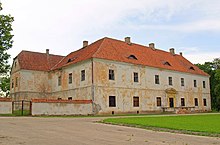Fircks (noble family)
Fircks ( Latvian : fon Firksi o. Fon Firkss ) is the name of an old Baltic noble family .
history
The family first appeared in a document in 1306 with the knight Gerhard von Ferckis in Estonia , royal Danish vassal of the Harrisch-Wier knighthood . The direct line of tribe begins with Wolmar Fircks , a vassal of the Teutonic Order in Wierland (Estonia) around 1450 .
Matriculations
The matriculation with the 1st class of the knighthood of Courland took place on October 17, 1620 for Christofer Fircks , ducal Courland burgrave and knight bank judge of the Courland knighthood . The Prussian permission to use the title of baron was granted on January 18, 1844 in Berlin for the royal Prussian major Wilhelm von Fircks . The Russian recognition of the right to use the Baron title for the full sex followed on September 1, 1853. Enrollment in the Livonian knighthood was in 1908 for Ernst Baron von Fircks made Heir to Nurmuiža Castle (Kurland) and Squire on Majorenhof ( Livonia ) .
Own
Nurmhusen Castle with the majorate (of 15,500 ha) belonged to Georg von Fircks from 1566 and remained in the possession of the Barons Fircks until the expropriation in 1920. The castle, built by the Teutonic Order at the end of the 16th century , is a high quality, originally preserved building. The late Gothic church, donated by Georg von Fircks in 1594, and decorated in Baroque style from 1673 to 1687, contains a number of family tombs. The Majorenhof in Riga-Strand had been in their possession since the 17th century.
Friedrich Ewald von Fircks (1733–1802) from Nurmhusen and Sehnjen owned the goods Rudbahren, Remessen, Stricken, Kandeln and Stackeldangen, as well as Hasenpoth Castle and Kalwen from the inheritance of his first wife Eleonore von Behr . Most of the properties were expropriated by the land reform of 1920 (see list below). Pedwahlen in the Talsi district belonged to Wolfgang von Fircks until the Germans were resettled in the Warthegau in 1939.
Until the expropriation by the land reform in 1920, the following goods belonged to the von Fircks family:
- Bächhof (Bikstu pagasts) - 2975 ha
- Bresilgen (Bruzilu) - 1300 ha
- Dubenalken (Dunalka) - 3680 ha
- Fircks-Pedwahlen (Firkspedvāles) - 740 ha
- Kliggenhof (Kliģu) - 875 ha
- Lesten (Lestene) - 5225 ha
- Lieven-Bersen (Līvbērzes pagasts) - 4285 ha
- Nurmhusen (Nurmuiža) - 15,500 ha
- Okten (Okte) - 2080 ha
- Rudbārži - 6,480 ha
- Samites (Zemīte) - 3485 ha
- Scheden (Šķēde) - 1860 ha
- Seeksaten (Sieksātes) - 1320 ha
- Stackeldangen (Štakeldanga) - 495 ha
- Strasden (Strazde) - 2870 ha
- Waldegahlen (Valdgale) - 2935 ha
- Vārve - 3380 ha
coat of arms
The split family coat of arms shows a black eagle in silver above and is nested in two rows of five places each of red and silver below. On the helmet with black and silver blankets an open black flight with a two-row chess bar occupied by four red and silver places.
Known family members
- Alexander Baron von Fircks (1817-after 1878), Russian corps general
- Alexander von Fircks (* 1940), former chief of protocol in Germany, head of the DAA protocol academy Hanover, specialist book author
- Annette Rexrodt von Fircks , writer and founder of the foundation of the same name
- Arthur von Fircks (1838–1900), Privy Councilor in the Royal Prussian Statistical Bureau in Berlin
- Friedrich Ewald von Fircks (1733–1802), Courland District Administrator of the Pilten district
- Juliane von Fircks (* 1969), art historian
- Karl Ferdinand von Fircks (1828–1871), German-Baltic poet
- Nikolaus von Fircks (1852–1941), Russian general
- Otto Freiherr von Fircks (1912–1989), German politician (CDU), Member of the Bundestag (1969–1976)
- Theodor von Fircks (1812–1872), German-Baltic engineer officer and writer
- Wilhelm von Fircks (General, 1794) (1794–1862), Prussian major general
- Wilhelm von Fircks (General, 1840) (1840–1896), Prussian major general
- Wilhelm von Fircks (politician) (1870–1933), German-Baltic politician
- Wolf-Dietrich von Fircks-Burgstaller (* 1948), German lawyer, rector of the University of Veterinary Medicine, Vienna
literature
- Genealogical Handbook of the Baltic Knighthoods (New Series) , Hamburg 2017, Vol. 7, pp. 273–409, 495–508.
- Genealogical manual of the nobility . Nobility Lexicon. Volume III, p. 277, volume 61 of the complete series, CA Starke Verlag, Limburg (Lahn) 1975, ISSN 0435-2408
Web links
Individual evidence
- ↑ Liv-, Est- and Kurländisches Urkundenbuch. Volume 2, No. 621.
- ^ Genealogical handbook of the nobility. Volume FA X, CA Starke-Verlag, 1977, p. 92.
- ^ Cf. Franz Brümmer : Fircks, Karl Freiherr von . In: Allgemeine Deutsche Biographie (ADB). Volume 48, Duncker & Humblot, Leipzig 1904, pp. 559-561.
- ^ Genealogical handbook of the nobility. Volume FA X, CA Starke-Verlag, 1977, p. 93.

















